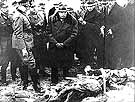
|
|
|

|

|

|

|
|
Click on an image to see a larger, more detailed picture.
|
|
|
|
|
| 1943: Death and Resistance |

|
pg. 445 |

|
|
|
|
| |
 In April 1943 the Germans uncovered the bodies of more than 4000 Polish POWs in the Katyn Forest, killed in 1940, apparently by the NKVD, the Soviet secret police. The Soviets denied all responsibility, contending that the Germans were to blame.
In April 1943 the Germans uncovered the bodies of more than 4000 Polish POWs in the Katyn Forest, killed in 1940, apparently by the NKVD, the Soviet secret police. The Soviets denied all responsibility, contending that the Germans were to blame.
Photo: Bildarchiv Preussischer Kulturbesitz
|
 The Polish government-in-exile in London suspected the Soviets of the massacre, and its insistence that a thorough inquiry be pursued led to a cessation of relations between the Russians and the London Poles. This provided a pretext for Joseph Stalin to establish a Communist government in Poland after the war.
The Polish government-in-exile in London suspected the Soviets of the massacre, and its insistence that a thorough inquiry be pursued led to a cessation of relations between the Russians and the London Poles. This provided a pretext for Joseph Stalin to establish a Communist government in Poland after the war.
Photo: Bildarchiv Preussischer Kulturbesitz
|
 The Katyn Massacre
The Katyn Massacre
In April 1943 members of the German Army discovered a mass grave in a heavily forested area just outside of Katyn, a remote Soviet village. An international commission of physicians identified the bodies--4143 discovered, but thousands more believed to be killed--as Polish officers and soldiers. According to the report issued by the German government, the men were captured by the Soviets during the 1939 Polish campaign; each was killed with a single shot to the nape of the neck just prior to the German invasion of Russia. When the Polish government-in-exile in London concurred with the report, Soviet leader Joseph Stalin broke off relations with the civilian regime and claimed that the Germans had committed the murders. The Allies upheld Stalin's claim until 1952, when a United States congressional inquiry concluded that the Soviet secret police were responsible. In April 1990 the Soviet Union acknowledged its responsibility for the Katyn Massacre.
Photo: Archive Photos
|
|

|

|

|

|
 April 19, 1943: The Bermuda Conference of Great Britain and the U.S., held in Hamilton, Bermuda, takes no meaningful action to help Jews in Europe. Before the meeting, representatives of both countries had agreed not to discuss immigration of Jews to their nations nor to ship food to Jewish refugees in German-occupied Europe.
April 19, 1943: The Bermuda Conference of Great Britain and the U.S., held in Hamilton, Bermuda, takes no meaningful action to help Jews in Europe. Before the meeting, representatives of both countries had agreed not to discuss immigration of Jews to their nations nor to ship food to Jewish refugees in German-occupied Europe.
|
 April 20, 1943: In the Warsaw Ghetto, Germans set fire to houses block by block and shoot all who emerge from buildings, bunkers, and sewers. Many Jews travel across rooftops and continue to fight. Patients at Warsaw's Czyste Hospital are murdered by German troops; See April 25, 1943.
April 20, 1943: In the Warsaw Ghetto, Germans set fire to houses block by block and shoot all who emerge from buildings, bunkers, and sewers. Many Jews travel across rooftops and continue to fight. Patients at Warsaw's Czyste Hospital are murdered by German troops; See April 25, 1943.
|
 April 20, 1943: Popular French film star Harry Baur dies in Berlin after being tortured by the Gestapo.
April 20, 1943: Popular French film star Harry Baur dies in Berlin after being tortured by the Gestapo.
|
 April 22, 1943: The Jews of Amersfoort, Holland, are deported.
April 22, 1943: The Jews of Amersfoort, Holland, are deported.
|
 April 25, 1943: As fires set by Germans consume the Warsaw Ghetto, a German Jew named Hoch desperately leaps from a fourth-floor window, breaking both arms and his spine; See Late April 1943.
April 25, 1943: As fires set by Germans consume the Warsaw Ghetto, a German Jew named Hoch desperately leaps from a fourth-floor window, breaking both arms and his spine; See Late April 1943.
|
|
|
|
|
| 1943: Death and Resistance |

|
pg. 445 |

|
|
The Holocaust Chronicle
© 2009 Publications International, Ltd.
|
|
